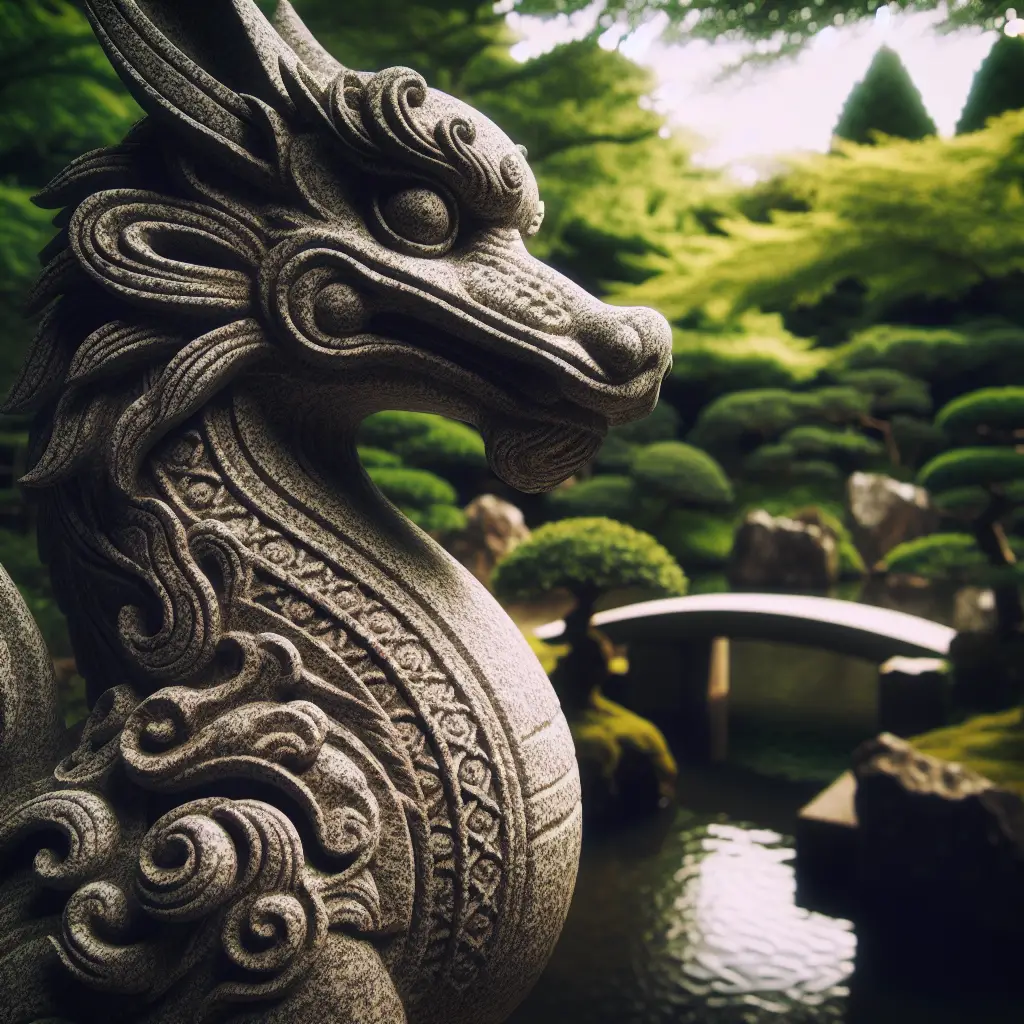In the captivating world of Zen garden design, animals play a significant role in creating harmony with nature. These serene gardens, with their meticulous arrangements of rocks, plants, and water elements, seek to evoke a sense of tranquility and oneness with the natural world. Animals, whether in the form of sculptures or living creatures, are strategically placed within these gardens to enhance the overall aesthetic and spiritual experience. Serving as powerful symbols and reminders of the interconnectedness of all living beings, animals add a touch of life and vitality to these carefully crafted spaces. From the graceful presence of koi fish gliding through pristine ponds to the serene contemplation of stone animal sculptures, the inclusion of animals in Zen garden design invites us to pause, reflect, and appreciate the profound beauty and wisdom of the natural world.
History of Zen Gardens
The history of Zen gardens can be traced back to ancient Japan, where these beautiful and serene spaces were created as a form of meditation and spiritual practice. Zen gardens, also known as Japanese rock gardens or dry landscapes, originated in the 8th century during the Heian period.
Origins of Zen Gardens
The origins of Zen gardens can be found in Buddhist temples, where they were created to facilitate meditation and contemplation. The first Zen gardens were designed as miniature representations of the natural landscape, incorporating elements such as rocks, gravel, and sand to symbolize mountains, rivers, and the ocean.
Evolution of Zen Garden Design
Over time, the design of Zen gardens evolved to incorporate more intricate patterns and symbolism. The arrangement of rocks and gravel became more deliberate, with each element carefully placed to create a sense of balance and harmony. Raked patterns in the sand or gravel were introduced, representing flowing water or waves.
Influence of Zen Buddhism
Zen Buddhism played a significant role in the development and design of Zen gardens. The principles of Zen, such as simplicity, mindfulness, and harmony with nature, are reflected in the design and philosophy of these gardens. Zen gardens became a way to experience and connect with the natural world, inviting individuals to find peace and tranquility within themselves.
Concept of Harmony in Zen Gardens
The concept of harmony is central to Zen gardens, as they aim to create a sense of unity between humans and nature. The following sections delve into how harmony is achieved in Zen garden design and the role animals play in this process.
Achieving Harmony with Nature
Zen gardens emphasize the importance of aligning ourselves with the natural world. By incorporating natural elements such as rocks, sand, and plants, these gardens create an environment that mirrors the beauty and tranquility of nature. The careful arrangement and attention to detail in Zen garden design promote a sense of harmony and balance, allowing individuals to connect with the peace and serenity found in nature.
Role of Animals in Creating Harmony
Animals have long been considered an integral part of nature and have a significant role to play in creating harmony within Zen gardens. They bring life and movement to these serene spaces, symbolizing the interconnectedness of all living beings. The presence of animals can enhance the sense of tranquility and make the garden feel more vibrant and alive.
Benefits of Harmonious Design
Harmonious design in Zen gardens offers numerous benefits to individuals seeking peace and relaxation. Studies have shown that spending time in nature can reduce stress, improve mood, and increase a sense of well-being. By integrating natural elements and animals into the garden, Zen gardens provide a space where individuals can experience these benefits and find solace in the beauty of the natural world.
Symbolism of Animals in Zen Gardens
In Zen gardens, animals hold symbolic meanings and are considered important elements in the overall design. Understanding the symbolism of animals can provide deeper insight into the philosophy behind Zen gardens and their impact on individuals’ spiritual journey.
Importance of Symbolism in Zen Buddhism
Zen Buddhism places great significance on symbolism as a means of conveying profound spiritual meanings. Animals, in particular, are often used as symbols to represent various qualities and teachings that are central to Zen philosophy. By incorporating these symbolic elements into the garden design, Zen practitioners are reminded of the deeper truths and principles they seek to embody.
Animals as Symbolic Elements in Garden Design
In Zen gardens, animals are used as symbolic elements that represent different aspects of the human experience and spiritual journey. For example, the koi fish symbolizes perseverance and determination, the crane represents longevity and wisdom, and the dragon signifies strength and transformation. By incorporating these symbols into the garden, practitioners are encouraged to reflect on these qualities and cultivate them within themselves.
Meanings and Interpretations of Animal Symbolism
The symbolic meanings of animals in Zen gardens can vary, depending on cultural and religious interpretations. However, some common interpretations include the koi fish symbolizing good fortune and abundance, butterflies representing transformation and rebirth, turtles symbolizing longevity and wisdom, and the lion representing courage and protection. These rich and diverse symbolisms add depth and spiritual significance to the garden, allowing individuals to engage with their own personal journey of self-discovery and growth.
Common Animal Motifs in Zen Gardens
Throughout history, certain animals have emerged as popular motifs in Zen garden design. These animals, each with their own unique symbolism and significance, are commonly found in Zen gardens and contribute to their overall aesthetic and spiritual impact. Some of these animals include:
Koi Fish
The koi fish, with its vibrant colors and graceful movement, is one of the most common animal motifs in Zen gardens. It is often associated with perseverance, abundance, and good fortune.
Butterflies
Butterflies, with their delicate wings and transformative life cycle, symbolize change, renewal, and the impermanence of life. They represent the transient nature of existence and the beauty of transformation.
Turtles
Turtles are revered for their longevity and wisdom. In Zen gardens, they symbolize a steady and patient approach to life, reminding practitioners to move forward at their own pace and appreciate the wisdom gained along the way.
Rabbits
Rabbits symbolize fertility, abundance, and agility. They represent the harmony between humans and nature, reminding us of the interconnectedness of all living beings.
Crane
The crane, known for its grace and elegance, symbolizes longevity, wisdom, and good fortune. It is often depicted in Zen gardens to invite a sense of tranquility, balance, and harmony.
Lions
Lions have long been associated with strength, courage, and protection. In Zen gardens, lion sculptures are often placed at entrances as guardians, symbolizing the protection of the garden and its tranquility.
Dragons
Dragons are mythical creatures that symbolize power, transformation, and spiritual enlightenment. In Zen gardens, dragon sculptures or motifs are used to evoke a sense of strength, wisdom, and the potential for personal growth.
Deer
Deer symbolize grace, gentleness, and inner peace. They are often depicted in Zen gardens to represent the beauty of nature and the harmony between humans and animals.
Peacocks
Peacocks, with their vibrant feathers and elegant demeanor, symbolize beauty, immortality, and the transcendent nature of the soul. In Zen gardens, peacock motifs are used to invite a sense of awe, inspiration, and spiritual awakening.
Snakes
Snakes have long been associated with transformation and the cycle of life. In Zen gardens, snake motifs are used to represent the shedding of old patterns and embracing personal growth and renewal.
The Role of Animals in Zen Philosophy
Animals hold a special place in Zen philosophy, representing various teachings and aspects of the spiritual path. In the context of Zen gardens, animals serve as teachers, manifestations of Buddha nature, and symbols of enlightenment.
Animals as Teachers of Zen
In Zen philosophy, animals are often regarded as wise teachers, embodying qualities and lessons that can guide humans on their spiritual journey. Animals demonstrate mindfulness, simplicity, and living in the present moment – all essential principles of Zen practice. By observing and learning from animals, practitioners can deepen their understanding of these teachings and incorporate them into their own lives.
Animals as Manifestations of Buddha Nature
Buddha nature refers to the inherent potential for enlightenment and awakening that exists within all beings. Animals are seen as manifestations of this Buddha nature, embodying qualities such as wisdom, compassion, and interconnectedness. By recognizing the Buddha nature in animals, practitioners are reminded of their own potential for awakening and are encouraged to cultivate these qualities within themselves.
Animals as Symbols of Enlightenment
In Zen philosophy, certain animals, such as the mythical phoenix or the enlightened Bodhisattva, are seen as symbols of spiritual enlightenment. These animals represent the ultimate goal of Zen practice – the realization of one’s true nature and the attainment of enlightenment. By incorporating these symbols into Zen gardens, practitioners are reminded of the transformative potential of their spiritual endeavors.
Integrating Animals in Zen Garden Design
The integration of animals in Zen garden design involves thoughtful placement and deliberate arrangement of animal elements. Whether through statues, sculptures, or living creatures, incorporating animals into the garden creates a harmonious and meaningful environment.
Placement and Arrangement of Animal Elements
When placing animal elements in a Zen garden, careful consideration is given to their positioning and relationship to other elements. Animals are often positioned at key focal points within the garden to draw attention and invite contemplation. Their placement is designed to create a sense of balance and harmony, complementing the surrounding natural and architectural elements.
Incorporating Animal Statues and Sculptures
Animal statues and sculptures are commonly used in Zen gardens to represent various animal motifs and symbolisms. These sculptures are often made of stone or bronze, giving them a weathered and timeless appearance. Carefully chosen and placed, these statues add a visual and symbolic dimension to the garden, evoking a sense of serenity, reverence, and connection with nature.
Using Living Animals in Zen Gardens
Living animals, such as koi fish or turtles, can also be incorporated into Zen gardens, adding movement, life, and a sense of vitality. Koi fish, for example, can be kept in ponds, while turtles can be housed in specially designed enclosures. By including living animals, Zen gardens become dynamic spaces, inviting interaction and fostering a deeper connection with nature.
Creating a Wildlife-friendly Zen Garden
Creating a wildlife-friendly Zen garden involves designing and maintaining the space in a way that supports and attracts a variety of wildlife. By providing essential resources and creating suitable habitats, Zen gardeners can encourage the presence of animals and contribute to biodiversity conservation.
Providing Water and Food Sources
Water is essential for both the survival and well-being of wildlife. Incorporating water features, such as ponds or small streams, provides a source of drinking water and attracts a diverse range of animals, including birds, insects, and amphibians. Additionally, planting native flowers, shrubs, and trees that provide nectar, fruits, seeds, or foliage can provide natural food sources for wildlife.
Selecting Native Plants
Using native plants in Zen garden design not only enhances the natural beauty of the space but also supports local ecosystems. Native plants are adapted to the local climate, provide food and shelter for native wildlife, and require less water and maintenance. Incorporating a variety of native plants also creates a more diverse and resilient habitat for animals.
Creating Habitat Features
In addition to providing water and food sources, incorporating various habitat features can further enhance the wildlife-friendliness of a Zen garden. Adding birdhouses, nesting spots, and bat boxes provide shelter and breeding sites for birds and bats. Creating rock piles or log piles can attract mammals, reptiles, and insects seeking shelter or nesting sites. These habitat features contribute to the overall health and biodiversity of the garden.
Interactive Elements with Animals in Zen Gardens
To fully engage with the presence of animals in Zen gardens, incorporating interactive elements can create opportunities for observation and engagement. By providing specific features tailored to certain species, Zen gardeners can encourage wildlife interactions and foster a deeper appreciation for the natural world.
Animal Feeding Stations
Feeding stations can be set up in Zen gardens to attract specific types of wildlife, such as birds or butterflies. Bird feeders filled with seeds, suet, or nectar can attract a wide variety of bird species, allowing visitors to observe their behavior and enjoy their presence. Butterfly feeding stations with native plants rich in nectar can entice these beautiful insects, creating a serene and enchanting atmosphere.
Birdhouses and Nesting Spots
Birdhouses and nesting spots provide safe and secure places for birds to breed and raise their young. By strategically placing birdhouses in the garden, visitors can witness the fascinating process of nest-building, egg-laying, and chick-rearing. These interactive elements foster a sense of connection and appreciation for the life cycle of birds.
Butterfly Gardens and Ponds
Butterfly gardens and ponds specifically designed for these delicate insects can attract a wide variety of butterfly species. By planting native flowers that serve as nectar sources and creating shallow pools or puddles for drinking and puddling, Zen gardeners can invite butterflies to visit and create a magical and whimsical environment.
Animals as Zen Garden Visitors
Zen gardens, with their natural beauty and harmonious design, often attract a range of wildlife as visitors. Encouraging the presence of animals in these serene spaces adds an element of life and vitality, enhancing the overall experience and connection with nature.
Encouraging Wildlife to Visit Zen Gardens
Creating a welcoming environment for wildlife involves providing the necessary resources and creating habitats that meet their needs. By incorporating native plants, water features, and sheltering elements, Zen gardeners can attract a variety of birds, insects, and small mammals. These animals will then contribute to the ecosystem of the garden, promoting balance and enhancing its natural beauty.
Observing the Interactions between Animals and the Garden
The presence of animals in Zen gardens invites observers to witness unique and captivating interactions between wildlife and the garden environment. Birds may use the garden as a resting spot or foraging ground, butterflies may gracefully flutter from flower to flower, and small mammals may seek refuge and food. These interactions offer an opportunity for visitors to gain a deeper appreciation for the interplay between animals and their surroundings.
Fostering a Sense of Appreciation for Nature
The presence of animals in Zen gardens serves as a reminder of the inherent beauty and wisdom found in the natural world. By observing their behavior and interactions, visitors can foster a sense of appreciation and reverence for the delicate balance of nature. This heightened appreciation can extend beyond the garden, inspiring individuals to become more mindful and protective of the environment.
The Healing Power of Animals in Zen Gardens
The healing power of animals in Zen gardens extends beyond aesthetic enjoyment. The presence of animals in these serene spaces offers numerous benefits for individuals seeking relaxation, mindfulness, and connection with nature.
Promoting Relaxation and Mindfulness
The soothing presence of animals in Zen gardens can promote relaxation and mindfulness. Observing their movements, behaviors, and connection to their environment can help individuals shift their focus away from daily concerns and immerse themselves in the present moment. This mindful connection with animals brings a sense of calm and tranquility, enhancing the overall healing experience.
Enhancing Well-being and Mental Health
Numerous studies have indicated that spending time in nature and interacting with animals can have positive effects on mental health and overall well-being. The serenity and beauty of Zen gardens, coupled with the presence of animals, can reduce stress levels, improve mood, and promote a sense of peacefulness. This enhanced well-being contributes to an overall sense of balance and fulfillment.
Instilling a Sense of Connection with Nature
Animals in Zen gardens not only provide aesthetic enjoyment but also foster a deeper connection with the natural world. The sight of a bird perched on a tree branch or a butterfly fluttering through the flowers creates a sense of wonder and reminds individuals of their place within the larger ecosystem. This connection can inspire a deeper appreciation for nature and a desire to protect and preserve it for future generations.
In conclusion, the history of Zen gardens is deeply rooted in ancient Japan and influenced by Zen Buddhism. These serene spaces aim to create harmony with nature and provide opportunities for contemplation and self-reflection. Animals play a significant role in Zen garden design, symbolizing important qualities and teachings. By integrating animals into these gardens and creating wildlife-friendly environments, individuals can experience the healing power of nature and cultivate a deeper connection with the natural world. So, the next time you find yourself in a Zen garden, take a moment to appreciate the presence of animals and the profound impact they have on our spiritual and emotional well-being.




